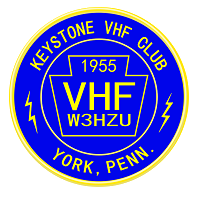Automatic Packet Reporting System (APRS) is an amateur radio-based system for real time digital communications of information of immediate value in the local area. Data can include object Global Positioning System (GPS) coordinates, non-directional beacon, weather station telemetry, text messages, announcements, queries, and other telemetry. APRS data can be displayed on a map, which can show stations, objects, tracks of moving objects, weather stations, search and rescue data, and direction finding data.
The APRS system is also linkable to the internet through a gateway. The Keystone VHF club hosts two gateways. The first gateway is on the standard 2 meter frequency of 144.39 Mhz. The W3HZU-1 gateway receives any packets it decodes and posts to the APRS network. The APRS system on 2 meters has its place, runs at 1200 baud, with Bell 202 tones using the AX.25 protocol. It requires a fair amount of power to be heard, and the network traffic is fairly high. To get started in APRS on 2 meters start here.
The second gateway is new and operates on the Meshtastic network as an APRStastic gateway. APRStastic is an open-source Python gateway that runs on standard Meshtastic devices (such as LongFast and 915MHz models). It allows users to send and receive APRS messages using pre-registered call signs. By integrating with APRS-IS, it extends your station’s digital footprint while complying with FCC and amateur radio rules. What is the advantage you ask? Meshtastic devices are less than 1 watt devices. They use an Apple or Android mobile device as an interface, so they are much easier to enter data than a 2 meter radio. They mesh together, so you don’t have to reach the server directly if another Meshtastic node re-transmits your message. Therefore the Meshtastic system is far more portable, and usable! To get started with Meshtastic read this great article by our friends at the (NEMARC) North Eastern Maryland Amateur Radio Club NE3MD.
The club APRStastic gateway has a short name of APRS and a long name of W3HZU-12. Amateur radio stations on Meshtastic must register with the service to use it. This allows all APRS traffic to remain unencrypted. Here are instructions on how to use it:
Only done once per server to register your callsign and SSID for your Meshtastic device. Send a direct Meshtastic message to node APRS. The system will respond with a welcome message.
!register N0CALL-1
If you wish to leave the system
!unregister N0CALL-1
Users can verify that they are registered by asking the Meshtastic node APRS in a direct message. The node will respond with the APRStastic software version number.
!version
Once the amateur radio callsign is registered, your GPS position will be i-gated to the APRS.fi service. Not only will you be able to be tracked by fellow hams online, you can send messages to other hams, send real email, send Winlink messages, and send SMS messages to phone numbers.
To send an APRS message to a radio callsign, invoke the APRS messaging my sending a Meshtastic direct message to node APRS structured like this:
N0CALL-1: body of message
To send an email to a real email address invoke the EMAIL-2 gateway by sending a Meshtastic direct message to node APRS structured like this:
EMAIL-2: [email protected] body of message
In order to send SMS messages to a real phone number, that phone number must Opt-In to the APRS SMS gateway at aprs.wiki.
Once the number is opted into the service, invoke the APRS SMS gateway by sending a direct message to node APRS like this using any phone number (example 717-000-1111):
SMS: @7170001111 body of sms message here
The phone number will receive a text message from the SMS Gateway number 866-352-4096.
To access the Winlink service invoke the the WLNK-1 gateway by sending a direct message to node APRS following the Winlink APRSlink gateway guide.
To begin a Winlink session ask to list your messages. It will prompt you to log in per the guide above. The trick is to use the colon character after the WLNK-1: invoke command. The system will respond with a request to log in with a challenge of a set of numbers per the guide.
WLNK-1: L
